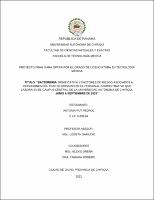| dc.contributor.author | Put Pedrol, Antonia | |
| dc.date.accessioned | 2023-08-17T14:44:00Z | |
| dc.date.available | 2023-08-17T14:44:00Z | |
| dc.date.issued | 2022-09 | |
| dc.identifier.uri | http://jadimike.unachi.ac.pa/handle/123456789/853 | |
| dc.description.abstract | Urinary tract infections correspond to one of the most common pathologies in the
population. Bacteriuria is the presence of more than 100 000 UFC / ml of a bacterium in
the urine, due to colonization in the urinary tract, the presence of symptoms is known as
urinary infection and the absence of symptoms is called asymptomatic bacteriuria. There
are risk factors that predispose the population to significant bacteriuria and develop a
urinary tract infection. Gram-negative bacteria are primarily implicated in this type of
infection. The objective of this study is to determine the prevalence of significant
bacteriuria in the administrative staff working on the central campus of UNACHI during
the period of June-September 2022. During the study it was determined that the
prevalence in the study population is 11% with significant bacteriuria and 89% population
without significant bacteriuria, the population was between the ages of 20 to 65 years.
Among the positive patients for asymptomatic bacteriuria, 87.5% correspond to the female
sex, unlike the male sex that was found 12.5%, among the underlying diseases 25% of
the population with significant bacteriuria were equivalent to people with diabetes, 62.5%
people who have an active sexual life, 38% postmenopausal women, 25% women who
use hormonal contraceptive and 50% women who do not use any type of contraceptives.
Among the microorganisms identified with the highest percentage, E. coli (50%), followed
by Enterobacter spp (25%), Proteus mirabilis (12.5%) and Pseudomona spp (12.5%). | es_ES |
| dc.description.abstract | Las infecciones del tracto urinario constituyen una de las patologías más comunes en la
población. La bacteriuria significativa es la presencia de más de 100 000 UFC/ml de una
bacteria en la orina, debido a la colonización en la vía urinaria, la presencia de síntomas
se le conoce como infección urinaria y la ausencia de síntomas se le denomina bacteriuria
asintomática. Existen factores de riesgos que predisponen a la población de padecer
bacteriuria significativa y desarrollar una infección urinaria. Las bacterias Gram negativas
son principales implicadas en este tipo de infección. El objetivo de este estudio es
determinar la prevalencia de bacteriuria significativa en los administrativos que laboran
en el campus central de la UNACHI durante el periodo de junio- septiembre de 2022.
Durante el estudio se determinó que la prevalencia en la población de estudio es de 11%
con bacteriuria significativa y 89% población sin bacteriuria significativa, la población
estaba entre las edades de 20 a 65 años. Entre los pacientes positivos por bacteriuria
asintomática un 87.5% corresponde al sexo femenino, a diferencia del sexo masculino
que se encontró 12.5%, entre las enfermedades de base, un 25% de la población con
bacteriuria significativa equivalían a personas con diabetes, 62.5% personas que
presentan vida sexual activa, 38% mujeres postmenopáusicas, 25% mujeres que usan
anticonceptivo hormonal y 50% mujeres que no usan ningún tipo de anticonceptivos.
Entre los microorganismos identificados con mayor porcentaje la E. coli (50%), seguido
por la Enterobacter spp (25%), Proteus mirabilis (12.5%) y Pseudomona spp (12.5%). | |
| dc.language.iso | es | es_ES |
| dc.publisher | Universidad Autónoma de Chiriquí | es_ES |
| dc.subject | ORINA -- ANÁLISIS | es_ES |
| dc.subject | URINA -- MICROBIOLOGÍA | es_ES |
| dc.subject | URINÁLISIS -- UNIVERSIDAD AUTÓNOMA DE CHIRIQUÍ | es_ES |
| dc.subject | TESIS - TECNOLOGÍA MÉDICA | es_ES |
| dc.title | Bacteriuria significativa y factores de riesgo asociados a infecciones del tracto urinario en el personal administrativo que labora en el campus central de la universidad autónoma de Chiriquí, Junio a Septiembre de 2022. | es_ES |
| dc.type | Thesis | es_ES |

